
Here’s a rare birdie. Spotted today on Seattle Craigslist, this ’76 Sunbird was corporate sibling to the Chevy Monza Towne Coupe, most of which dissolved by around 1990. I’d much prefer a Bonneville Brougham or Grand Prix LJ if we’re talking ’76 Pontiacs, but my radar locked on to this one due to its scarcity.
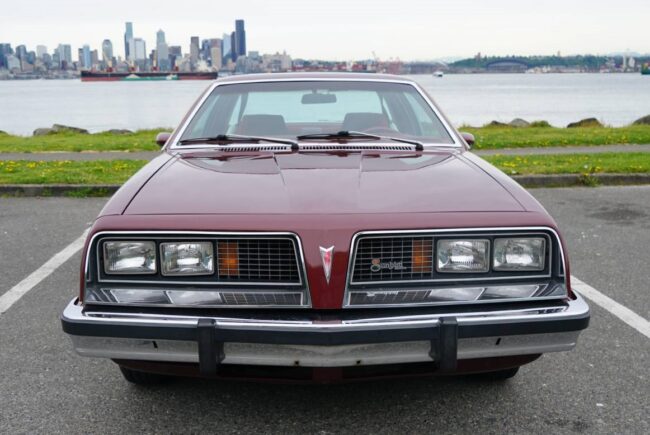
They loved to rust, like most ’70s cars, and probably 99% of them had the bark beaten off of them. No one saved them, no one particularly cared to save them. But this one survived!
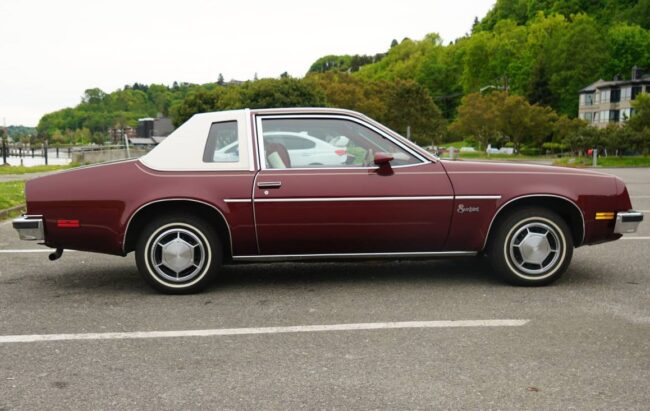
And in a sea of silver, white and black 2021 combovers today, it really stands out, though it was only a slightly upwardly mobile subcompact when new. And the dark red with brite red velour and white landau top looked pretty good to your author.
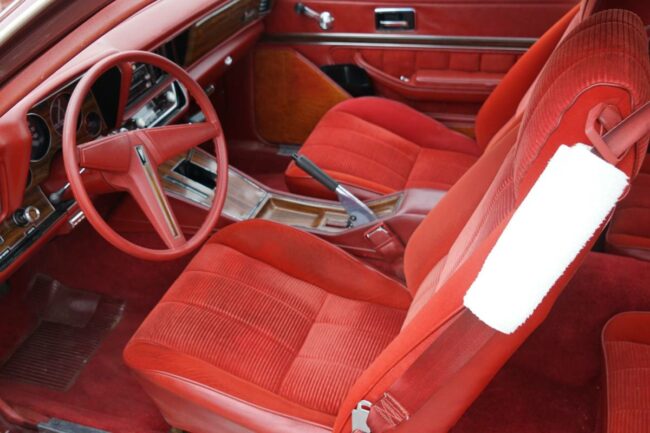
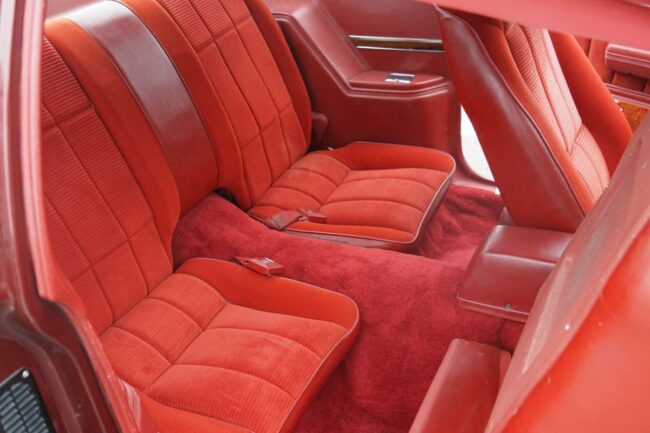
The ad is short and sweet, but at least there were a ton of nice pictures. “1976 Sunbird, 117,000 miles! 3.8 Liter V-6 engine, pristine condition, white Landau top, automatic transmisson, $9500 obo.
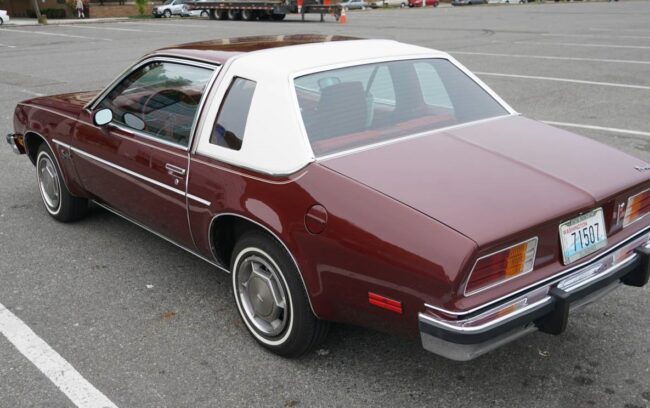
“Starts every time and drives great, A/C blows cold. Radio works great. Collectors plates, no mechanical issues. I don’t drive the car enough to justify keeping it.”
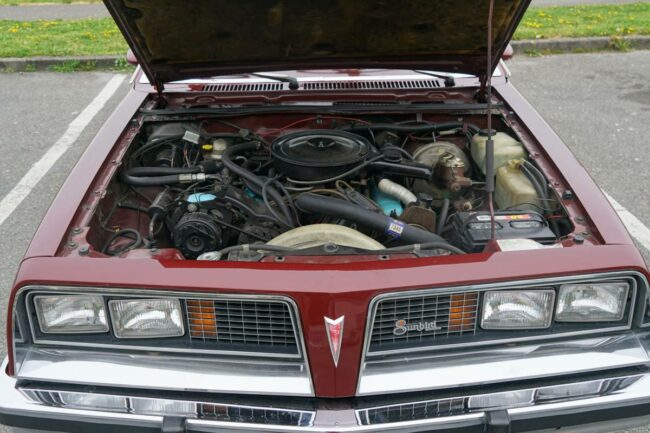
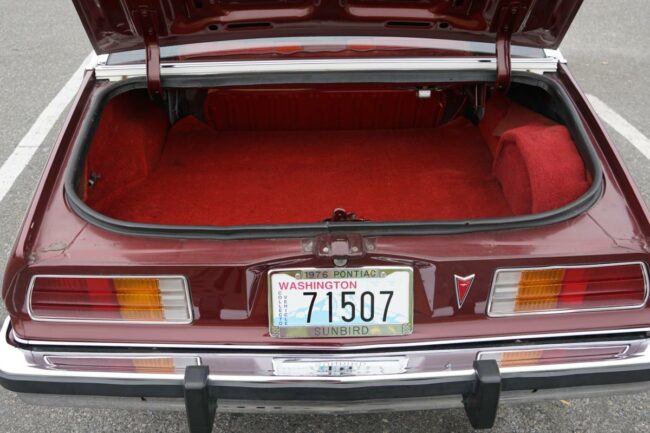
It was originally listed at a mirth-inducing $25,000 but the ask is down to $9500 as of this writing. Is it worth that? I don’t know, but it looks remarkably well-preserved. Maybe if you had one as your first car. Anyway, cheers to it for surviving 45 years!







72 Comments
I wonder what mpg that thing gets compared to today? That GM V-6 automatic probably got like 17/23 or something like that?
The performance of a first generation Prius running with lots of dead battery cells combined with the gas mileage of new F-250 with its biggest gasoline motor and heaviest body.
Darn that interior is nice for such a cheap small car.
It reminds me of the horrible Mustang II my friend had in high school, but it was a 4cyl. Looks about the same wheelbase and that driveshaft hump splitting the back seat was the same in the Mustang II if my bad memory serves me this morning.
What kind of crazy high school were you in where boys fixated on the problems created by RWD, available V8s and the concomitant bulky driveshaft tunnels had on rear leg room?
Well, I know why I appreciated a flat, spacious rear seat when I was in high school.
consumer reports subscriber?
You really don’t get it.
Oh I get it. The only small cheaper coupe allowed in 1976 was the Accord. After all, Honda had skipped the not small expense of engineering different body styles and different powertrains like GM or Ford to give the youth a set of choices and instead relied on spiritual but compensated fellow travelers who got their subversive inspiration from Hunter Thompson and Pete Wenner.
I believe you were reaching for Jann Wenner, not Pete. As for HST, as a man who experimented to see if overinflating the tires on a Caddy Coupe de Ville could get it to handle like a Lotus Elan, he doesn’t strike me as having been an Accord kind of guy.
Ronnie you are correct about Wenner’s first name but you are absolutely wrong on the subversive influence of that crowd on auto journalists. Something as fun and productive as giving a high school kid an old Mustang or so he can turn a Sunbird into a Funbird with sweat equity is just automatically shat upon by sloganeers like Andy. Where did Andy get such corrosiveness?
That slut’s fantasy about the Virginia fraternity house showed how far that crowd will go to defame something that doesn’t pass their smell test of cool. Gutter people.
When I see “ordinary” cars like this in such good original condition I really am always curious about the story behind it. Did a secretary treat herself to a fancy new car as a retirement present and then spend the next 40+ years only taking it out of the garage on Saturdays for bridge club and Sundays for church and brunch?
I had a friend who did exactly that in the early ’80’s with one of these.
He had been retired for a few years, and bought one of these (gently used); and took care of it like it was a Rolls-Royce. I doubt that he drove it more than a couple hundred miles a month. The car was still in showroom condition when I left for college in ’90. I don’t know what happened to it after he passed.
My first thought was that this was Eno’s car, until I saw the Washington plates.
This car seems to have been restored…..believe it or not, these never had that Seville like color matched trunk carpet, I think these originally had trunk mat and splatter paint. The cloth upholstery and pattern doesn’t seem correct.
Thats gonna knock off some points at Pebble Bleeech……
Yeah, didn’t think the trunk carpet was right. Someone had some surplus brite red fabric from So Fro Fabrics I guess.
The seats do appear to be correct though, per the brochure: http://oldcarbrochures.org/United%20States/Pontiac/1976%20Pontiac/1976%20Pontiac%20Sunbird/slides/1976%20Pontiac%20Sunbird%20page_02_03.html
They do look correct, I was thinking of the cloth seats on the Skyhawks which didn’t have pleats in them from what I recall.
Vertical pleats. Hatchbacks continue the interior carpet to the tail.
They sure did have the carpet in them. I owned one. Silver paint, bordello red interior with the 3.8 and 5mt. Got 38 mpg at 60mph.
GM used to run ads for the awful cars they built in the early ’80s that benchmarked these Monzas and Sunbirds. The X-cars and J-cars weren’t quite ready to measure up to the imports, but GM loved to point out how bad the cars they foisted on the public in the ’70s were. The cars that replaced them were much bigger on the inside, much lighter, and much more efficient. They were probably also somewhat serviceable. They were still often the last GM cars people bought.
A friend who lived across the street from my grandparents in Massachusetts owned at least five of these at one point, with perhaps as many as two running at once. It was a pretty white-collar neighborhood, but my friend loved working on machines and turned his parents’ driveway into a parts yard. The year before he’d bought a Pontiac colonnade as he was about to get his driver’s license. I think the rust got it. The Monzas and Sunbirds followed.
When they were new, I was a big fan of the Dekon Monzas that raced in IMSA, an enthusiasm that spilled over to the ones that were Vegas under the skin instead of tube-framed racing cars. Riding in my friend’s Monzas and Sunbirds taught me things I’d never known about how bad a car could be from riding in my parents’ Mopars. The noises that emanated from the suspension were harrowing. The impacts that came through the suspension on the same roads that didn’t trouble my family’s cars were confusingly violent. The idea that you’d buy an entire car because the previous owner had just replaced the ball joints before the transmission failed was bewildering to me as a thirteen year old.
The following year my friend had discovered Toyota pickups, and the days of junkers were over. Except that I helped him reclaim his 1979 Trans Am from his ex-girlfriend’s house in the mountains. It wasn’t running and she’d smashed all the windows and slashed the tires. We changed the tires and pulled it out of the woods with his Toyota. Then I drove it down the mountain without the benefits of power steering or power brakes while sitting in a pool of broken glass. Good times. Did I mention that the last of these Pontiacs was used up and rusted out garbage by 1985?
You lost me when your friend discovered Toyota pickups because he was worried about rust and flimsy suspensions. I think he might have been seeking them out.
Not by the 1980s. Earlier Japanese trucks rusted – frightfully, since they were designed in, and for, a semi-tropical environment where snow was a rarity and road-salt a strange American waste.
But the Japanese companies, especially Toyota, were committed to doing things right; and they learned. UNLIKE GM, which just laughed at how their planned-obsolescence program simply had cars’ useful lives shorter and shorter. They laughed…until they noticed that their sales figures were lower, too.
They may be trying to do it right, now. I don’t know and I don’t care. But for too often in the past, they were criminally exploitative.
The Japanese-brand trucks (made in the United States, unlike the American brands which are made outside the US) now are at least as resistant to corrosion and often rack up nearly twice the miles, on average. A 110,000-mile Tacoma is a nearly-new Tacoma.
I could listen to you for for hours Just Passin Through. We they rusted it wasn’t Toyota’s fault. When they stopped rusting it was because Toyota showed they cared in a beautiful way. When you look down at the odometer of the Taco truckster and it says 110k, she has not aged one bit from when your eyes first adored her. Makes you wish Mr. Toyoda had a sister.
And on the other hand, I get quickly bored of fanbois. GM is great, GM is the gold standard, and when it isn’t, just pretend it is.
Wedded to a brand and a Narrative. It’s why Cadillac went from being, legitimately, a quality luxury car, to a badge-engineered, shortcut-designed, shoddily-built generic GM POS.
Partly because the GM managers figured that the retired pediatricians would just keep buying, like they always did.
And for awhile they did, but demographics constantly change. The retired reflexive buyer aged out and went the way of all flesh, and the young people of the 1970s, who discovered Japanese coupes as well-assembled and well-designed (aside from the rust problems) continued to buy Japanese, as they, too, now enter the retired demographic.
Personal story: In the 1982 recession, I took a survival job as a tow-truck driver. We had the contract for a local Pontiac dealer – who had, as a sideline, the Honda franchise in that area.
(My, how things change…)
Anyway; I was pulling in some dead GM Mark of Excellence, and was told to set it out back…next to the row of Civics. And I did…the “row of Civics” were about 20 horribly-rusted Gen1 Civics that had been put there, obviously to be collected by a scrapper.
Once liberated of my load, I went inside. “What’s with all those Civics?” I asked. I needed a Winter Car. “Any way I could buy one, cheap?”
“Nope” said the repair manager. “Honda bought them all back. We peeled the VIN tags off, to send to Honda; and the recyclers are coming for those in a day or so.”
When has GM…or Ford or Chrysler or even AMC or Studebaker…ever, EVER done that? Ever see a 1960 Oldsmobile after four years in winter salt? I sure have.
Japanese makers (less Nissan, now, which has taken up the French Way with Renault ownership) is open to learning and is protective of the customer relationship. Or was…even Toyota is going in the wrong direction, now…but they’re still magnitudes better than American companies.
As are their products, and this has been so for 40 years.
Even better than a Taco…. a rusty Civic on death’s door?
You are just to good to be true
I can’t take my eyes off you
You would be like heaven to touch
I want to hold you so much
At long last love has arrived
And I thank God I am alive
Meanwhile poor second class Nissan gets no credit for buying back their fiery but mostly peaceful vans. I guess the heart wants what the heart wants.
Maybe you didn’t catch this one.
HONDA BOUGHT THEM BACK.
When was the last time GM bought back its engineering goofs that cost customers thousands? How about, never?
The most recent one I know about was buying back a batch 1st gen Saab 9-5s. They had lightened the flywheel and loosened the old Triumph engine to make it rev better and were rewarded by Chrysler 2.7 or Camry V6 style sludge
The bed rusted off his first Toyota truck when it was about seven years old, at which point he welded one up out of diamond-plate. I’ve heard that was because they had to bring them in without beds and buy American made ones because American trucks have been protected since before anyone ever used one as a car. I don’t know what you mean by flimsy suspensions. I drove that thing up a fire road that was so eroded it had waterfalls when the Toyota had about 200,000 miles and the only issue was that the tailgate fell off. I was low-range crawling over stuff that would have challenged my hiking boots, and the truck shrugged it off like a trip to the store.
“the truck shrugged it off like a trip to the store”. It must have gone through a great number of tailgates in 200k. I did enjoy how the rust was the fault of American protectionism. Naughty protectionism, making the busy, important Japanese man dance around the port before he can sell the hippy his rusty truck.
John, how much personal experience do you have with 1970s era American cars? Do you really think they were mechanically superior and better assembled than the 1976 Honda Accord (which had A/C and a stereo as standard equipment while the American brands were still charging a la carte prices)?
You seem to think that consumers were stupid and had no personal experience with Japanese cars that were better built than the domestic competition.
As a native Detroiter I appreciate what profits at the domestic automakers can do for a community, but the simple truth is that the domestics failed to compete in the 1970s, laying the groundwork for losing a big fraction of market share.
Were there cultural factors that may have helped the imports? Sure, but the main reason why the domestics lost market share is that they didn’t serve consumers as well.
Yes, I do think they were superior. Do you the 2 speed auto in the 76 Accord would have served the owner better than the THM 250 served the long term owner of this Sunbird? Do you think many first year CVCC engines made 117,000 miles and counting like the 3.8 Buick V6 in this car. Do you think what ever small gas saving was enough to cover the extra maintenance of all the valve adjustments and drive belt changes the Honda required and the Pontiac did not? Do you think the thinner sheet metal of the Accord better protected the driver from rust or accident damage?
Anyway that was all unknowable in 1976 as the Honda was an unknown quantity. Yet you and your cohort ran to it shouting halleluiah. That was your politics talking not your car judgement.
That was your politics talking not your car judgement.
Perhaps because of my interest in slot cars as a kid, I gravitated to being a fan of road course racing, so by the time I got my driver’s license I was interested in cars that could handle, something most American cars made in the ’60s and ’70s could not do. My older brother’s first car was a Buick Special convertible. He replaced that with a Lotus Cortina (a great, but flawed, car), and when he decided to start restoring that, he bought a ’63 Mini Cooper, which was barely a car but it introduced me to well-handling FWD cars. As a teen I also had friends who owned 1st gen Ford Capris, which were made in the UK and Germany and also a lot of fun to drive. The early Capris used the same “Kent” four cylinder engines that were the basis of the Lotus Twin Cam. When the ’73 oil crisis hit, a good friend, who had inherited a Mercury Montego with a 351 Cobra Jet engine from his dad who had died suddenly, traded it in on a Lotus Europa, which got about 3X the gas mileage as the CJ got. Influenced by my brother and friend, the first car that I personally bought was a ’66 Lotus Elan (it was ridden hard and put away wet but only $1,600 in 1974). I still have it, disassembled.
Politics had nothing to do with my interest in foreign cars. My brother and friends did influence me and they liked foreign cars because they were mechanically interesting and handled well. Hell, I doubt my brother has ever even picked up a copy of Rolling Stone in his life.
Anyway that was all unknowable in 1976 as the Honda was an unknown quantity.
By 1976, Honda had been selling reliable motor vehicles in the United States for almost three decades. For the sake of argument let’s say the air-cooled N600 and Z600 weren’t real cars, but they’d been selling the Civic here since 1972. When my brother bought one of the first Accords sold in the US, it was his second Honda, having owned a Honda 450 motorcycle. By then I had owned a Honda 90 and a 305. To Accord early adopters, Honda was very much a known quantity.
My dear old Dad had a Monza for a while. He liked Fords mostly, so it didn’t stick around long. The chief thing I remember about it is how pretty the first runner-up to the homecoming Queen looked in the passenger seat.
A friend had one with a V8 in it, I believe. It’s hard to believe so many of us survived the days of bias-ply.
I believe the Monza V-8 was the first car that required loosening of the motor mounts and a partial engine pull to get at the back spark plugs. I always thought they were nice looking cars but every one that I saw was a terrible rattle trap and falling apart within a few short years and by the mid-80s they were mostly gone.
I love how some folks totally lose their minds and start a battle royale over a 45 year old car I wrote up on a whim. *Dr. Evil laughter*
Some of us are old enough to remember how terrible these were as primary transportation.
Yea – the good old day of the 1970s and early 80s, when your only options for half-way decent quality and durability were full-size American cars that had emission choked V-8s that got 12 mpg (on a good day) and had the handling responsiveness of an aircraft carrier, or a few high end German and Swedish brands that were reasonably well built and nice to drive but cost more than a year’s middle-class salary to buy and maintain, or a few Japanese brands that were cheap to buy and well built but total rust buckets within 3-5 years if you lived anywhere they salted the roads. Pretty much everything else was falling apart, rattling, rusting, blowing head gaskets, and/or had workmanship that would make a drunk ape proud before they even left the showroom. As a teen during the 70s my dream cars were pretty much all from the 1960s or earlier except for a few Germans that were way out of reach. That is why I find such cars as the Pontiac above amazing – how could anyone cherish such a piece of crap?
Here is to the proud, drunk apes. Hip, Hip. Hooray GM was lucky to recruit them. May their enemies never be as happy as the apes on the day this fine Sunbird sauntered down the line in 1976.
British, French, Italian, and VW “apes” did similarly lousy jobs at assembly during the 1970s and into the 80s. On the other hand, if you ever compared a GM car from 1964 or earlier (66 for Cadillac) to anything GM from the 1970s you would see that GM did a much better job of training their apes during the earlier era.
Gosh, I was hoping one or two Asian assembly workers from some also ran company might earn your title of proud, drunk, ape. I guess you reserve it for your own and select Euro friends.
Now that Bill Cosby has finally been freed, perhaps he will go back to Ford for the Quality is Job One ads. Showing actual workers on the line doing their best, and that an ape’s best is not so bad.
Unlike their North American and European counterparts, the sake drenched apes working for Toyota, Nissan, and Honda had managers who embraced Prof. Demming’s statistical quality control methods.
I started working at DuPont’s main automotive paint lab in 1982. That was the same year Honda started assembling cars in Ohio and we supplied Honda’s Marysville operations with paint. At the time DuPont was also GM’s primary paint supplier. GM’s standard at the time permitted 10 paint defects per 1,000 finished cars. Honda’s standard was 1 per 1,000.
Demming was a quack. Monitoring and by definition gaming the process instead of inspecting the product is absurd on the face of it. Might as well listen to Tony Robbins.
Well, that explains why you dismiss Japanese cars and worship American crap-boxes. Probably the last single person of your generation to so do.
Because you don’t understand Demming’s work, what he did for Nissan and then all of the Japanese motor industry, as well as other industries.
I guess if you don’t or will not understand quality, you reject the choices others make, based on quality differences.
Again I’ve pointed out……..HE DOESN’T EVEN OWN AN AMERICAN CAR…..
Its nutjob stuff on both ends really……..
Show us on this doll where Roger Smith touched you…..
Wait till I submit my Austin Marina article 😆
April, let me predict, a la Johnny Carson:
“The Marina was a paragon-a PARAGON, I tell you!-of the finest British craftsmanship.”
“Eh no, it was the Trabant, you dummy. England sucks!”
“You 2 are both idiots, the best car was the Yugo, so shut up!”
“Nope, nope nope. Those three cars were all garbage, the finest car ever made was the Belchfire Eight, so there! I win the Internet!”
-As Sheriff Bart said in Blazing Saddles, always like to keep my audience rivited… 😆
You convinced me Tom, I am all for the Belchfire 8, you win the internet, as per usual.
Philately will get you nowhere.
The Citation sold almost a million in its first year. All the magazines called it car of the year. Those buyers didn’t listen to Hunter S Tompson or trend setters from California. They took their hard earned money and voted with their wallet and gave GM a chance, and GM let them down.
The X body is a great example of the kind of anti mid America bias I am talking about. When it debuted it delivered a full line of engines that beat the performance engine by engine of the old X in addition to vastly better economy and room in a small package. Though BL had done that in UK with the wedge ADO71, Volkswagon wasn’t able to offer anything like that with the Dasher, nor poor Chrysler with the k, and broke Ford just stretched an Escort 5 years later. Toyota waited 4 years and only had one engine that they had outsourced from Yamaha. Honda was no where man sitting in their no where land.
When you ask what was wrong with the X, yes the vertical radio was weird, a bad engine or transmission? No you just get a bunch of vagary that sounds like ambulance chaser stuff. What did GM do? The repackaged the same car into a more conservative package that attracted a crowd that didn’t listen to Hunter Thompson subversive types and was rewarded by 15 years of strong sales and a good reputation of quality. Yet here you guys are calling Americans apes and mouthing sheister talk.
I never owned an X car; although I came close to buying a Schitte-ation.
Here’s the story of someone who did. Someone who was not a flake – he was an established engineer-turned-plastics-entrepreneur.
http://www.joesherlock.com/BadOmega.html
That is your evidence JPT, Sherlock?. The jack off drives badly ends in a ditch after jumping out the window! like no sober person ever and starts writing Roger Smith. Then he gets 126,000 miles out of it and sends his daughter to college in it. Sounds like his money’s worth to me and he just resented having to buy a conservative car to take around his clients, to whom the real him would repulse. I bet he also hated the barber giving him short hair cuts for the same reason. I did like the guest appearance of Jack who was like 10 but still at the ready with 1-800 sheister talk. At least those charmers have moved on to destroy the Boy Scouts.
So the X-body was a wonderfully engineering and carefully crafted automotive nirvana, and anyone who doesn’t agree is some sort of anti-American foreign car loving nutjob? Let us look at the evidence – the X-body got tremendous positive publicity and reviews from nearly all the automotive media of the time, and initial sales were far beyond GM’s expectations – so far so good. Yet within 2 years sales collapsed as stories started to appear about brake problems and generally poor quality, and later reviews were unable to get anywhere near the same performance figures of the launch vehicles which suggested that GM used carefully built and tuned ringers to get those positive reviews. In fact, I don’t believe you will find any vehicle line in automotive history that went from hero to zero with such huge magnitude and speed, and the only way GM was partially able to save financial face was to put the slowly improved X-body chassis under the new A-body cars that did not use the same names or any of the same styling cues to distance themselves as far as possible from the X-body debacle. So anyone who hated their X-body and traded for a Honda or Toyota is some crazy loon who just irrationally hates American cars and was brainwashed by the Japanese sympathizers writing for C&D – is that about right John?
Stingray the Sherlock story was presented to me to advance your argument and I offered some pretty darn obvious take aways. I know I haven’t convinced you, You fantasize that your German cars are still built by blond white coated technicians who put aside their work on the super fast Leopard tanks to build the pride of Munich. Who wouldn’t want that when America can only offer drunk apes who come from a long line of sharecroppers. Guess what Stingray your factory was always filled with swarthy Turks who think their mother was a she wolf and the pride of Munich is lighting up their stadium in gay colors to piss off Hungary. You got scammed. Hunter Thompson is smiling in hell.
I’m not sure what your issue with Hunter Thompson is, but the cars that he is most closely associated with were fullsize American convertibles that he called “Sharks.” There’s the Coupe de Ville of Fear and Loathing in Las Vegas (which may or may not have been fictional) and he actually owned a red Caprice convertible that’s on the cover of a couple of his books. If you can point to his work where he advocated driving Japanese cars, please do, but I’d guess the vast majority of Americans who bought Japanese cars in the last quarter of the 20th century didn’t even know who HST was.
My problem with Thompson and his ilk was his outsized influence on all forms of journalism. Think of the shift from people like Chersterton and Orwell that did their best to build society and make it better by advocating different ideas rising from their different politics. Now think of the modern acolytes who just smooch their favorites while deconstructing everything around them. In this way as it applied to auto journalism, the Japanese cars are just the tool at hand to destroy. sort of the way Michael Avenetti is built up by CNN to destroy Trump.
The 1970 deVille convertible was real, there is a photo with Thompson and the car in the parking lot of The Landmark Hotel. From what I recall, he had a full size Pontiac convertible as his personal car, though the “Shark” they rented in Fear and Loathing was a 71 Impala convertible.
The movie uses a 71 Eldorado convertible in place of the deVille.
The fact that GM further developed the platform doesn’t take away from the fact that the X cars were quantifiably terrible. They were rushed to market and deserve their status as emblematic of the Malaise Era. I owned a Pontiac Phoenix and it’s quite possible that it was even worse than the Austin America my father bought and drove briefly. The X cars had serious driveability issues and almost ran better when they dieseled after you shut them off. They were hard to start and very easy to stall, often in the middle of traffic. The brakes were adequate at best and service was a nightmare. To change the battery you had to remove a stiffening brace between the shock tower and the front bulkhead that was obviously an engineering afterthought.
What was most disappointing to me about the X cars was the fact that GM had done a great job on the downsized 1977 fullsize sedans. Those cars were well designed, well engineered, and well built for the day. I had a hand-me-down Caprice and it was a fine car.
A smart man once told me, “Don’t defend a mistake.” The X cars were a mistake.
The only people I knew that had a Citation had white on red 80 hatchback until they replaced it with a Saturn in the early 90’s so some people did have good ones on occasion.
They also had a Collonade Cutlass that they replaced with an 85 Cadillac Coupe deVille.
At their best (such as the ringer press vehicles) the X-bodies were pretty impressive for their time. If you optioned the vehicle well, and got one built during the middle of the day on a Wednesday (i.e. after the weekend hangovers had worn off and before TGIF mindset set in) you had a decent chance of getting a reasonably well built and functioning Citation or Omega (at least if your normal driving routines didn’t involve braking hard on a wet road). The major difference between the X-body (and Detroit more generally) and Japanese cars during the 70s and early 80s were that you didn’t have to worry what time of week or day your Datsun, Honda, or Toyota was built so that you would have a reasonable chance that the paint, body panel gaps, trim attachment, etc. were done properly, or that the engine and gearbox would run like well-oiled sewing machines. The other area that became increasingly apparent during that time was the lack of extra effort Detroit put into their smaller cars. GM made a huge investment in the X-body, but then tried to save $4 by designing new transaxles with only 4 speed manuals or 3 speed automatics, and a new V-6 that was pushrod to go with the lumpy 20 year old Iron Duke 4 instead of investing a bit more to offer a really good 4 cylinder mated to overdrive manuals and automatics as the Japanese were doing. Sure the Iron Duke might last longer than the smooth running Honda OHC 4, but you had to listen and feel every agricultural vibration and reluctance to rev during your 120,000 miles of life as the body rusted out from under you if you were unlucky enough to get a lousy Friday afternoon paint job on your Citation. Ford did the same thing by giving the US a cheapened Escort rather than the excellent European version. There are very good reasons why so many life-long American car buyers were willing to pay over sticker price on a Honda or Toyota small car during that era.
You are giving the iron duke a bad rap. It, with a gap, replaced the 153 Superthrift cut down of the Chevy 6. In the late 60s, the 153 had 90 gross horsepower with no emission controls. The iron duke managed 90 net with a full set. Not many engines gained power between 69 and 79. Toyota, to their credit managed to hold the Corona power steady at the same 90 net horsepower, but only by increasing the displacement 20 percent from 1.9 to 2.4 liters. As far as the extra displacement, when you know that 75+% of your cars are going to be automatic, you purposely give some extra torque to help smooth the automatic shifting.
I wonder what you think period Japanese line workers did on the weekend. Marathon sessions of the game of Risk, helping them plan the capture of Kamchatka.
,
I have little doubt that Japanese line workers also partook in heavy drinking or other activities not conducive to production line efficiencies, and I am well aware the Turks and other non-Aryans comprise most/many of the assembly line workers in Germany (I’ve toured several assembly plants), but whether it was better management, unions more willing to allow management to fire bad workers, or the right of workers to stop the line when they seem something going wrong, the end result was consistently higher quality among Japanese and German cars during the 1970s and 80s when US quality slipped badly. My guess is that US workers and even managers are not to blame, but instead it is UAW and Detroit managerial culture that were the main culprits, because the Japanese and German manufacturing and assembly plants in the US were never noted for offering lower quality than the home territory plants, and I’ve never heard a car buyer say they were going to avoid a Kentucky Toyota, Ohio Honda, or Carolina BMW because they were US built.
Iacocca had UAW President Douglas Fraser on the Board of Directors and somehow it was still Morning in America with K cars multiplying. Meanwhile Perot was on the GM board and leaving turd piles all around because he wanted, and got Green Mail like some demon wall street shill. George Meany at the AFL-CIO supported the Vietnam war because it was good for workers, refused to let the union movement be a tool of MLK, and let local chapters choose who they allow to associate. A simple person earning a middle class living is not the enemy. Those that hollow out are. When institutions are destoyed, nothing is there to replace. A union is a great thing for a simple person, the more people looking out for him the better the chance of a good outcome. Conservatives should actually try to conserve something. Otherwise you are in the preposterous position of two Indian women for President in 2024 and try to keep a straight face when you say mine is better than yours. Do you really think you will get anywhere with that?
Perot could see the rot within GM, because…HE KNEW HOW TO RUN A COMPANY…… the fact they paid him to get rid of him rather that…..well. listen to a man who went from a computer salesman in Texas to a billionaire within the span of 25 years showed that there was, and really still continues to be a problem within the company. Perot bought GM cars and still continued to even after they got rid of him, I remember seeing a documentary following him in his day to day activities when he was running for President in 1992, he still drove a 1985-1987 or so Oldsmobile 98 to the office.
I at least put my money where my mouth is, unlike John, who again, to re-state the fact DRIVES A VOLVO, have had lots of GM cars, all of them have given good service, they couldn’t have all been Wednesday cars, and I still buy GM if they have something that I like, which is getting harder and harder these days……
That last paragraph is a diamond. I laughed out loud. Thank you!
I’m sure the amount of Japanese line workers throwing bolts and nuts into the bodywork while getting high and drunk on the job was also much lower than at the typical UAW establishment…….when they showed up that is….
You must have spent much time in the closets and locker rooms of car factories around the world to have hard data on that… Tell me…. do Japanese workers wear boxers or briefs? After all, you know so much about where they keep their nuts.
They admitted they did it themselves, there is video evidence of Chrysler assembly line workers get drunk and high at lunch and this isn’t in the “ludes and beer” era of 1977, this is a video from 5-6 years ago…….dumb schmuck.
Several friends of mine had these, well into the mid-80’s. In the late-70’s, I briefly dated a young lady who had the Buick Skyhawk version of this car with an option package called the Nighthawk. It was a fairly well loaded (for the times) Skyhawk with black paint and special reflective decals with the Nighthawk legend prominently featured. FWIW, I can say that the driveshaft tunnel was not an impediment to our activities. 3.8L V6 and an automatic, the car was pretty zippy at that time.
A couple of other friends had the Oldsmobile Starfire version of this car, both with the 3.8L V6 but one with autobox and the other with the OD five speed. My buddy who had the five speed car (Starfire SX!) and I were roommates in our college years and swapped cars or driving chores often. I came to appreciate the paint-shaker V6’s power coupled with the manual trans, the car was a pretty decent drive. Especially compared to my 1979 Pinto ESS, which was the ‘sporting’ Pinto at the end of the car’s production. It was saddled with the 2.3L Lima motor and a four speed OD trans, while smaller and somewhat lighter, the Lima motor was emissions-strangled and had a hard time getting out of its own way. But I had really cool plaid fabric covered seats!
Back in the day, my then-girlfriend, now-wife had a choice between a 1980 Monza Town Coupe (new) or a 1977 Olds Delta 88. She chose the Olds, but mostly because it was the first car she was going to finance on her own and didn’t have the credit history for a new car (remember those days?). We’ll never know how it would have turned out with the Monza, but the big Olds was a great choice.
That’s a crackpipe price on that car, hardly anyone really cares much about an H-body these days. Maybe the V8 Monza Spyders, but little else. It would be cool to find the Formula version of the Sunbird, but I have a hard time imagining any still exist.
The Skyhawk also had a cool glass “Astroroof” option that basically gave you a glass fixed panel over the drivers seat, like a Ford Skyliner from the early 50’s, it came with a panel you could put underneath to block out the heat if needed.
The 1970s Sunbird/Skyhawk were attractive cars. The hatchback coupes were frank knockoffs of Ferrari’s 365GTB 2+2 in their styling.
They were pretty common sights in the early 1980s, then seemingly all disappeared at once. I’ve never read a road test of them, or seen one at a car show. They’re small, light RWD coupes that can accomodate a small-block V-8. Someone, somewhere must have built a fast one.
I had one of those. Mine had a full vinyl roof, imitation leather appolstery and a 5 speed manual tranny. It was FUN to drive!